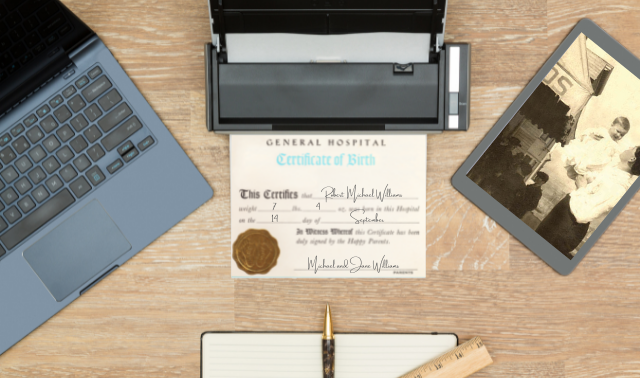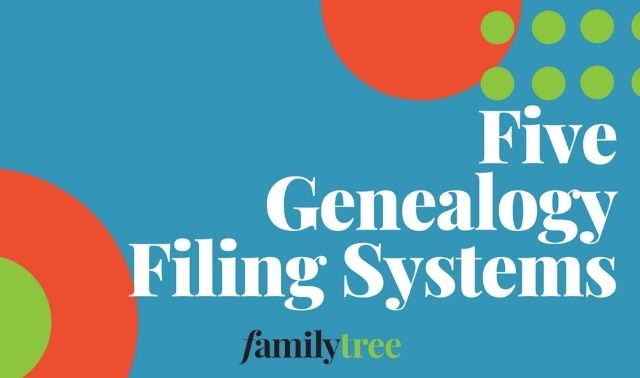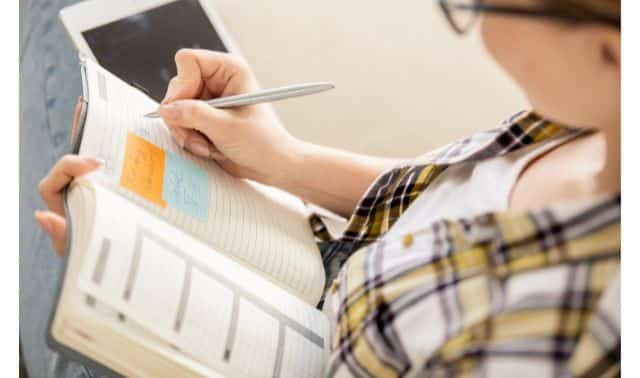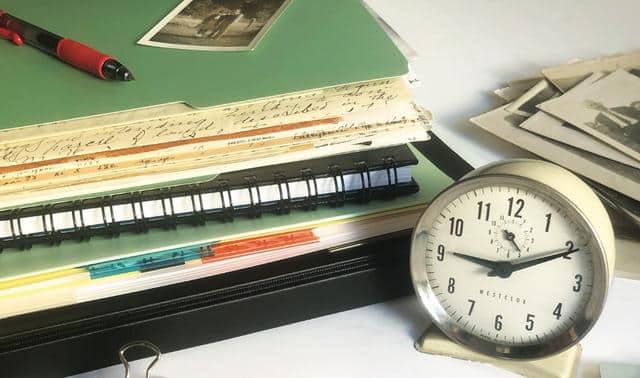Sign up for the Family Tree Newsletter! Plus, you’ll receive our 10 Essential Genealogy Research Forms PDF as a special thank you.
Get Your Free Genealogy Forms
"*" indicates required fields

Even before my husband and I bought our first home, I was addicted to HGTV. It’s amazing how the channel’s interior designers can transform spaces—even tiny apartments—into gorgeous and functional living areas. These shows have actually been known to siphon my attention away from finding my great-grandpa’s naturalization records.
I’m lucky that my new home has space for an office (or should we say genealogy room?), which is definitely an upgrade from sitting on the couch with my laptop and a notepad. Figuring out what to do with it is challenging. But experimenting, watching HGTV, scouring Pinterest and talking to fellow researchers has helped me to make my—oops, I mean our—office into an inviting, efficient space for genealogy research and other work.
So what would the ideal genealogy space look like? How could it be functional for research, comfortable and inspiring, and help you organize your ever-growing piles of books, papers and photos? (And your digital files, too.) Whether you have a whole room to work with or just a corner, you can use these 11 ideas to make over your genealogy workspace.
Some things are must-haves for doing genealogy research effectively, and these items are among them. Here’s what to look for in each piece, including options for the budget-conscious and space-challenged:
1. Find Enough Room
One of the most important features of your genealogy workspace is a table or desk. It seems obvious, but you’d be surprised how many people research hunched over on the floor and kick the dog off the sofa to spread out papers. That’s a good way to lose things and put a crick in your neck (not to mention displease Fido). You need to be able to sit comfortably with enough surface area for your computer, documents and notes.
A rollout keyboard tray is convenient and ergonomic for a desktop computer. If you have a wireless connection to your printer and scanner, you don’t have to worry about where to put these devices. Otherwise, your setup should have room for them.
If you don’t need a keyboard tray, you could look for an old desk from an antique shop or flea market. Also check out Craig’s List or your local Freecycle group. The Freecycle Network lets group members list their unwanted items for free (sometimes businesses post used stuff when they’re upgrading or moving). Garage sales and secondhand stores (Goodwill, the Salvation Army and Habitat for Humanity ReStores) also offer deals on gently used furniture.
For lots of workspace at arm’s reach , an L- or U-shaped desk is ideal. But if you’re working with a tiny area, go for a desk with a hutch or hang shelves above the desk. The vertical storage lets you clear clutter for more usable desktop. You also can maximize workspace in a small area with a corner desk.
No room for a dedicated genealogy area? Don’t relegate yourself to the floor. You could get a folding table (typically under $30) to set up when you need to spread out and take down when you’re through, or use a portable laptop table. (Ikea makes several.)
2. Find the Right Chair
The hours have a way of flying by when you’re searching for ancestors online. Sitting for hours on end in the wrong position can injure your back, wrists and other body parts you need to remain on friendly terms with, so it’s essential to have a supportive chair. You might feel like Goldilocks when chair-shopping: Too soft, too hard, too big, too small.
The best advice to find one that’s just right: Try out chairs in office-supply and home stores, search for online reviews of models you’re considering, and check the return policy in case it doesn’t work out.
You’re not just looking for pillowy soft. Consider these ergonomic guidelines: When you sit and type on your keyboard, your arms should form an L shape with forearms almost parallel to the floor. Your feet should be flat on the floor with knees bent at a 90-degree angle, and the chair should support your back when you sit up straight.
3. Provide Enough Light
Lighting is often an afterthought (or a never-thought), but having enough of it in your genealogy space will help you avoid eyestrain and headaches as you surf the web and decipher documents. Just as with chairs, consider ergonomics for lighting.
UCLA offers a great online resource that explains the best types of lighting for working on computer and reading paper documents. HGTV’s lighting guide provides a short primer on various types of lighting and what type of light is best to use where.
Buy the Right Supplies
4. Tall Bookshelves
With all your books, Family Tree Magazines, journals and other materials, bookshelves are must in your genealogy space. They come in all shapes (such as the traditional rectangular unit or one with square cubby holes) and sizes.
If your floor space is limited, go tall. Just avoid backless shelves unless you don’t mind fishing papers from behind them. Price ranges vary widely, too, and this is another area where hunting down used furniture can save you money.
To keep magazines and skinny paperbacks from slouching over on the shelves, get yourself some magazine holders. You can find simple black magazine file for cheap, or you can go for pricier faux leather versions from Staples.
Wicker or fabric cubes that fit on shelves or in-cubbies attractively hide office supplies (nice if you research in the dining room). They’re available at Crate & Barrel, Ikea, Target and other stores.
5. File Cabinet
Keeping all your family group sheets, charts, record copies, correspondence, notes and other papers organized is a challenge met most readily with someplace to store your files.
For most of us, that means a file cabinet (even if Grandma’s birth certificate has to share a drawer with the bills). It doesn’t have to be a traditional, big metal one. A wood (or wood composite) finish might better suit your taste and décor.
Researching in borrowed space? Try a portable crate or rolling file cart you can tuck into a closet, or let your filing cabinet double as an end table or nightstand. Or you can hole-punch papers and put them in binders.
Blank walls do nothing for your décor or your genealogy motivation. The right visuals, on the other hand, can warm up your space, tell your family’s story and help you figure out your next research move. Deck your walls with these ideas:
6. Wall Map
A large map of the United States, Europe, or wherever in the world you research is art that doubles as a genealogy tool. Put stickers or pushpins where your ancestors spent time and highlight their migration routes.
If you belong to AAA, you may be able to get a USA road map for free. Another option is to buy a wall map from National Geographic or Maps.com. You can mount them on corkboard and mark locations with pushpins or buy transparent removable colored stickers made for that purpose.
Many sites offer laminated maps for extra durability or marking up with a dry-erase marker. An easy way to mount maps and charts on the wall is with 3M Command hanging strips.
7. Family Tree Chart
What could be better for a genealogy room than a family tree chart on the wall? If you’re a visual person like I am, having names and relationships larger than life and just a glance away is more illustrative than clicking to your online tree (plus, it eases impromptu family history explanations to your spouse). Those just starting to research might want a blank chart to fill in along the way.
You can buy decorative blank family tree charts from genealogy vendors or have them printed at sites such as Family ChartMasters. Or go the bargain route: Download Family Tree Magazine’s free, blank five-generation family tree and take the PDF file or a printout to a copy store such as FedEx Office to enlarge it to poster size. Select no lamination if you plan to pencil in new ancestors.
8. Ancestor Display
While you may already have some framed photos around your home, adding pictures in your genealogy room creates a visual reminder of the lives you’re trying to uncover—and the future generations with whom you hope to share that heritage.
You even could hang them in the formation of a family tree chart (especially nice with wedding pictures). And a bulletin or magnet board for posting mystery photos just might propel you through those brick walls.
Ikea is one of my favorite places to pick up inexpensive frames and bulletin boards. You also can find frames at a thrift or craft store and paint them to match.
Have you inherited Grandma’s handkerchief collection or Great-grandpa’s reading glasses? Use a small shelf or a shadowbox frame to display these mementos where they’ll remind you of your loved one. See here for tips.
9. Chalkboard Wall
Putting black paint on a wall is a brave decorating move, but black chalkboard paint makes this bold choice a useful one as well. You’ve probably seen this in playrooms for kids to doodle and practice their ABCs.
In a genealogy room, you could use a chalkboard wall to track your research to-do list, draw a family tree chart, or write out clues, “CSI”-style, to a family tree mystery. Look for brands of chalkboard paint at home-improvement stores.
Access Tech Tools
Aside from your computer and printer (preferably an all-in-one with scanning and/or fax capabilities), a couple of other tools will help you take advantage of genealogy websites and software, and help you secure your data. Look into these:
10. External Hard Drive
Changing technology and crashing computers can render years of research inaccessible. Or make you do this: I’m guilty of keeping my old CPUs around way too long because I’m nervous they have some document I forgot about, but will need the second I drop off the computer at an electronics recycler.
Now is the time to invest in an external hard drive. These drives come with tons of memory, take up considerably less space than that old CPU and still work with newer computers that lack disc drives. Consider hooking up the external drive to your computer.
For tips on buying external hard drives and other electronics to equip your genealogy room, see this article.
11. Ergonomic Computer Tools
Don’t stop your ergonomic efforts with a chair and lighting. An ergonomic computer mouse and keyboard will save you wrist pain and strain by protecting against repetitive motion injury (thus allowing you to safely and comfortably extend your research sessions).
Experts recommends a keyboard that can be height-adjusted and will keep your hands and wrist in a neutral position—not bent—at all times. Ergonomic mice come in a variety of styles: joystick-style pointer, trackball, touch pad and round “puck.”
The Occupational Safety and Health Administration recommends selecting a device built specifically for your dominant hand that comfortably fits the size of your hand, moves with minimal force and doesn’t require the wrist to bend while using it.
You might as well go all-out with keyboard and mousepad wrist rests to keep your wrists in the correct position. Look for them in office supply stores and on electronics sites. Ergonomic keyboards run about $30 to $60; a mouse will cost between $15 and $70.
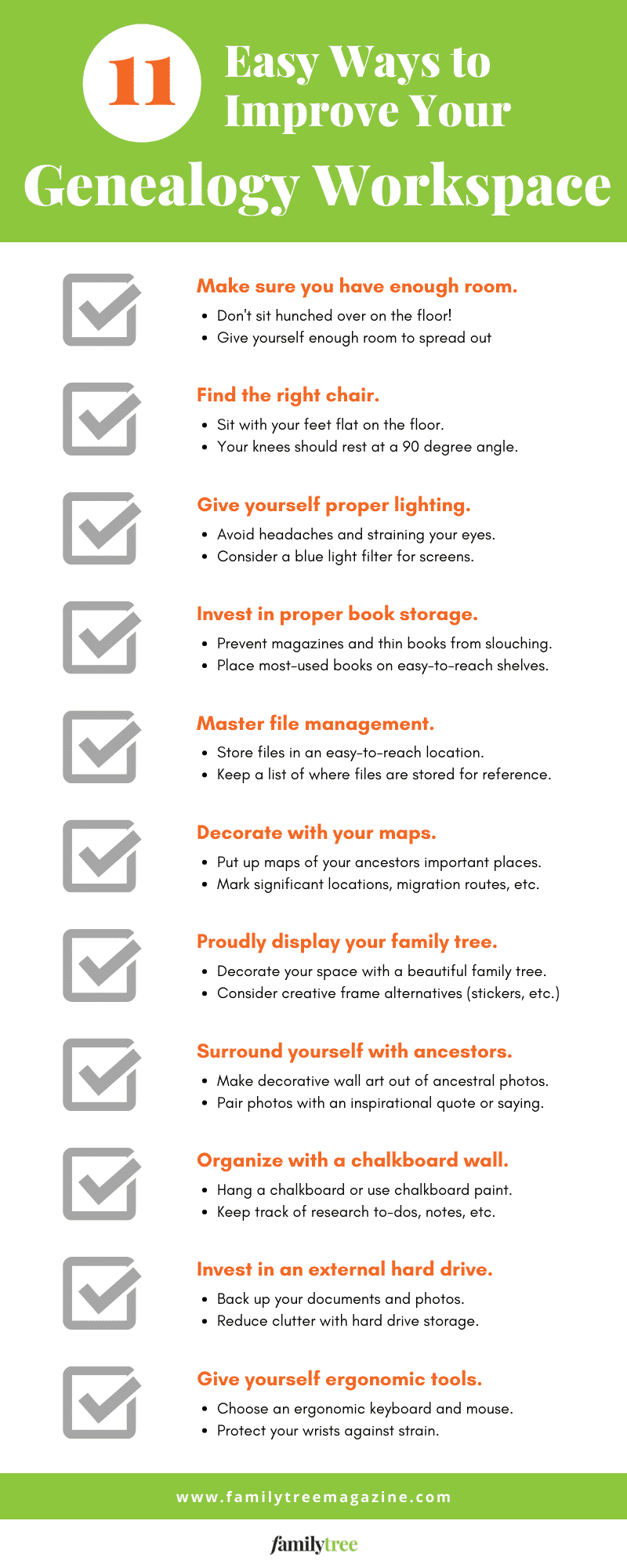
A version of the article appeared in the February 2012 issue of Family Tree Magazine. Last updated, February 2025.

